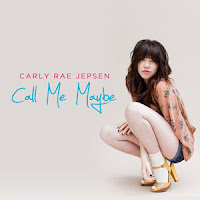The Song
"Call Me Maybe" is probably one of simplest pop song forms you'll ever see, consisting of just a verse and a chorus. There is a bridge (that unusually happens to repeat at the end of the song), but it's really just a slight melody change with some different lyrics over the chorus. The form looks like this:
Verse, Chorus, Verse, Chorus, Bridge (Chorus), Interlude, Chorus, Bridge (Chorus)
To add more time to the song since it's so short, each chorus is repeated with just a few of the lyrics changed. Speaking of the lyrics, they fit the song well and are written around a single sentiment that most people can relate to - giving your number to someone you're attracted to. There's not much of a story, and it almost seemed like the lyric writing was rushed since it feels very incomplete, especially the bridge.
The Arrangement
The arrangement on "Call Me Maybe" is interesting for a couple of reasons; first of all, there's really not a bass instrument that can be easily heard. The low end is supplied by what sounds like a synthesizer, although a bass could be in the mix but mixed down pretty low, or it could even be a baritone guitar. Which brings us to the second point. The main instruments (strings hi and low, guitar chords, bass synth) are playing the exact same figures throughout the 2 sections of the song. In fact, I keep waiting for the bass to break out and play a walking line or counter figure, especially after the snare fills during the song, but it never happens.
The song starts with two bars of eighth note string hits (it almost sounds like it could be a sampled guitar), which is joined by a quarter note kick drum (4 on the floor), the lead vocal, and either a guitar or another synth playing a lower part underneath the opening strings. Halfway through the verse the high hat, stereo harmony vocals, and a guitar playing a lower string pedal enters.
On the chorus the vocal is doubled, a new bigger kick sound is introduced along with an exploding snare sample, and a new string line doubled with a guitar enters. When the chorus repeats, a second guitar enters on the right playing chords and a different guitar enters on the left playing a double-time line to add some movement to the song.
On the second verse, the hat pattern is slightly different and a soft snare enters. There's also a bass synth/baritone guitar from the chorus that continues to play. The vocal now has a harmony above it, but it's in mono instead of the spread stereo of the 2nd half of the B sections.
The Bridges are interesting in that they're basically a chorus with different melody and a guitar counter line.
There's a hard ending to the song but it's done fairly cleverly with slow-down, pitch-down of the existing instruments to give the song some finality.
* The Foundation: kick drum, exploding snare in the chorus
* The Rhythm: high hat, guitar in the second half of the chorus push the song the most. Strings, bass synth and guitar chords push it less.
* The Pad: none
*The Lead: vocals
* The Fills: guitar counter line in the bridge
The Sound
The sound of "Call Me Maybe" is very in your face, especially the vocals. The only ambience is the short stereo room on the strings, and a long timed delay on the fill guitar in the bridge.
The harmony vocals of the verse and chorus are doubled and spread left and right, and the guitars in the chorus are mono and panned to the left and right, but most everything else is mono and panned to the center.
As is the case with most pop songs today, this one is fairly compressed, especially the vocals. You can sometimes hear the compressor pumping on the vocal, and it sounds like there was a lot of sibilance that was attenuated with a de-esser, almost too much since you sometimes can't distinguish the "S's" in the song.
The Production
For a song that has just 2 1/2 sections (if you count the bridge/chorus), it does develop pretty well dynamically-speaking. If you listen closely, you can hear the instruments enter and exit especially from the beginning of the song until just after the first bridge. Sometimes it's subtle, but there's always something new happening to capture your attention.
The vocal performance by Carly is especially strong as it varies just enough to keep the melody from being boring, yet never sounds forced. In fact, you could say that it even carries the song, which is exactly what you want in a pop song.
Send me your song requests.
----------------------------------
You should follow me on Twitter for daily news and updates on production and the music business.
Don't forget to check out my Music 3.0 blog for tips and tricks on navigating social media and the new music business.






